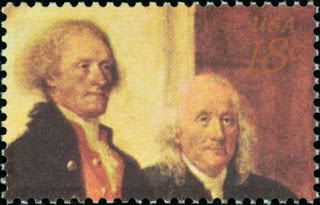The Spirit of 1776.
1629 - 1630 - 1631 - sheet. 1631a
-
Archibald MacNeal Willard (August 22, 1836–October 11, 1918) was an American painter who was born and raised in Bedford, Ohio.Willard joined the 86th Ohio Infantry in 1863 and fought in the American Civil War. During this time he painted several scenes from the war.
Willard painted The Spirit of '76 in Wellington, Ohio after he saw a parade pass through the town square.(previously known as Yankee Doodle).
-
Interphil.
International Philatelic Exhibition.
1632
-
Flags From The U.S.A.
Delaware.
1633
-
Pennsylvania.
1634
-
New Jersey.
1635
-
Georgia.
1636
-
Connecticut.
1637
-
Massachusetts.
1638
-
Maryland.
1639
-
South Carolina.
1640
-
New Hampshire.
1641
-
Virginia.
1642
-
New York.
1643
-
North Carolina.
1644
-
Rhode Island.
1645
-
Vermont.
1646
-
Kentucky.
1647
-
Tennessee.
1648
-
Ohio.
1649
-
Louisiana.
1650
-
Indiana.
1651
-
Mississippi.
1652
-
Illinois.
1653
-
Alabama.
1654
-
Maine.
1655
-
Missouri.
1656
-
Arkansas.
1657
-
Michigan.
1658
-
Florida.
1659
-
Texas.
1660
-
Iowa.
1661
-
Wisconsin.
1662
-
California.
1663
-
Minnesota.
1664
-
Oregon.
1665
-
Kansas.
1666
-
West Virginia.
1667
-
Nevada.
1668
-
Nebraska.
1669
-
Colorado.
1670
-
North Dakota.
1671
-
South Dakota.
1672
-
Montana.
1673
-
Washington.
1674
-
Idaho.
1675
-
Wyoming.
1676
-
Utah.
1677
-
Oklahoma.
1678
-
New Mexico.
1679
-
Arizona.
1680
-
Alaska.
1681
-
Hawaii.
1682
-
Alexander Graham Bell.
1683
-
Commercial Aviation.
1684
-
Chemistry.
1685
-
Surrender of Cornwallis at Yorktown.
The Siege of Yorktown, Battle of Yorktown, or Surrender of Yorktown in 1781 was a decisive victory by a combined assault of American forces led by General George Washington and French forces led by the Comte de Rochambeau over a British Army commanded by Lieutenant General Lord Cornwallis. It proved to be the last major land battle of the American Revolutionary War in North America, as the surrender of Cornwallis' army prompted the British government eventually to negotiate an end to the conflict.
1686
-
Declaration of Independence.
The Declaration justified the independence of the United States by listing colonial grievances against King George III, and by asserting certain natural rights, including a right of revolution. Having served its original purpose in announcing independence, the text of the Declaration was initially ignored after the American Revolution. Its stature grew over the years, particularly the second sentence, a sweeping statement of individual human rights:
1687
-
-
Washington Crossing The Delaware.
Planned in partial secrecy, Washington led a column of Continental Army troops across the icy Delaware River in a logistically challenging and potentially dangerous operation. Other planned crossings in support of the operation were either called off or ineffective, but this did not prevent Washington from successfully surprising and defeating the troops of Johann Rall quartered in Trenton. The army crossed the river back to Pennsylvania, this time burdened by prisoners and military stores taken as a result of the battle.
Washington's army then crossed the river a third time at the end of the year, under conditions made more difficult by the uncertain thickness of the ice on the river. They defeated British reinforcements under Lord Cornwallis on January 2, 1777, and defeated his rear guard at Princeton before retreating to winter quarters in Morristown, New Jersey.
1688
-
-
Washington at Valley Forge.
Though several locations were proposed, he selected Valley Forge, Pennsylvania, 18 miles (29 km) northwest of Philadelphia. It proved to be an excellent choice.
1689
-
-
USA Bicentennial 1776-1976.
1690
-
Declaration of Independence.
1691
-
1692
-
1693
-
1694
-
Olympics 1976.
Diving.
1695
-
Skiing.
1696
-
Running.
1697
-
Skating.
1698
-
Clara Louise Maass (June 28, 1876 – August 24, 1901) was an American nurse who died as a result of volunteering for medical experiments to study yellow fever.
1699
-
Adolph S. Ochs.
1700
-
Christmas.
1701
-
Christmas.
1702 - 1703
-
Washington at Princeton 1777.
Painting from Paile.
1704
-
Centennial of Sound Recording.
1705
-
Pueblo Art.
Zia.
1706
-
San Ildefonso.
1707
-
Hopi.
1708
-
Acoma.
1709
-


































































































Geen opmerkingen:
Een reactie posten
Opmerking: Alleen leden van deze blog kunnen een reactie posten.